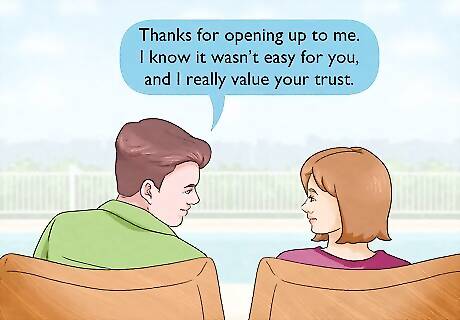
views
X
Expert Source
Casey LeeLicensed Professional Counselor (LPC)
Expert Interview. 20 June 2022.
People with this attachment style often shy away from emotions or shut down when it comes to other people’s needs.[2]
X
Expert Source
Liana Georgoulis, PsyDLicensed Psychologist
Expert Interview. 6 September 2018.
By making your partner feel safe and accepted, you can get closer to each other and create a loving, fulfilling partnership. Read through this article to learn everything you need to know about avoidant attachment styles and how you can help your partner feel more secure.
Determine your partner’s specific attachment style.

Figuring out their specific style will help you understand them. Typically, someone with an avoidant attachment style is staunchly independent, but almost to a fault. They will take care of themselves and have trouble letting other people in. If your partner has an avoidant attachment style, they might be uncomfortable talking about emotions and have trouble meeting your needs. There are 2 different types of avoidant attachment styles: Dismissive-avoidant: This is the more common type of avoidant attachment style. They tend to push everyone away and rely only on themselves. Someone with a dismissive-avoidant attachment style probably doesn’t have many close friendships or relationships. Fearful/anxious-avoidant: This is the rarer type of avoidant attachment style. They tend to push people away, then pull them back in for fear of losing them. They might have a few close friendships and relationships that they often struggle with.
Accept your partner for who they are.

Putting pressure on your partner to change can make them feel anxious. When an avoidant person feels like they “aren’t enough,” they tend to withdraw, which can damage your relationship. You can absolutely encourage your partner to seek help and better themselves, but accept them for who they are right now, too. That way, neither of you will have any hurt feelings. It’s important to respect your differences, too. Your partner may do or say things that you don’t understand, and that’s okay. The important thing is that you both respect each other without judgment. You can really make a big impact on them if you can validate and understand their avoidant behavior and give plenty of space, slow down, and affirm what they are trying to do.
Listen to your partner’s problems.

Many avoidant types feel like their emotions and issues don’t matter. The more you can listen to your partner and reassure them that they’re valid, the more safe and comfortable they will feel with you. Check in with your partner often, and listen to their problems whenever you can. Over time, they’ll feel better and better about coming to you with issues instead of burying them down deep. When your partner is talking, practice active listening by making eye contact and asking follow-up questions.
Be dependable.

Avoidant personalities often feel like they can’t rely on anyone. By showing your partner that you’re reliable and dependable, they’re much more likely to trust you. Make sure that you always keep your word, and be 100% honest with your partner. Over time, their trust in you will grow, and your relationship will get that much stronger. When you make plans, always stick to them. Try not to be late. Don’t talk about your partner behind their back. Be honest about where you are and who you’re with.
Be honest about your needs.

When you’re honest, your partner doesn’t have to guess. People with avoidant attachment styles sometimes struggle to meet their partner’s emotional needs, which can make them feel stressed. Be upfront about what you need in a relationship to avoid miscommunication and make your partner feel better. Say something like: “In order for me to feel secure in our relationship, I’d really like it if we saw each other at least 3 times a week. How does that sound to you?” “I really like it when we text each other throughout the day. Do you think you could text me at least a few times a day, just to let me know what you’re up to?”
Ask them about their needs.

Avoidants often have trouble prioritizing their needs. If you ask your partner about what they need from you, they’re much more likely to tell you. Try to check in with your partner often to see how they’re doing, and make space for them to bring up any issues that they want to. “How are you feeling about our relationship?” “Is there anything you wanted to bring up with me?” “Are your emotional needs being met in this relationship?”
Give them space when they need it.

People with avoidant attachment styles need a lot of time on their own. If your partner asks for some space or wants to be by themselves, don’t take it personally. Try to respect their need for alone time, and welcome them with open arms when they’re ready to talk again. If you notice that your partner looks distressed or anxious, try asking, “Do you need some alone time?” That way, they’ll know that you understand their needs, and they can tell you what they need at the moment. In their mind, they are afraid things can get worse and escalate in your relationship if they don’t pull away or shut down. You need to have empathy and work with them.
Express your emotions in a neutral tone.

Avoidants tend to shut down in the face of emotions. If you’re telling your partner how you feel, do it in a calm, neutral tone of voice. That way, they’ll be more receptive to it, and you can have a more productive conversation together. “I felt a little bit frustrated earlier when I couldn't get ahold of you. It makes me worried when I don’t know where you are.” “I was upset when you canceled our plans yesterday. Could we talk?” Your partner's avoidance is likely due to both biological vulnerabilities and past painful experiences that created uncomfortable emotions.
Praise their positive behavior.

If you appreciate their efforts, they’re much more likely to repeat them. When your partner does something nice for you or is vulnerable with you, thank them for being open and point out what they did well. Positive reinforcement goes a long way, and with time, they’ll learn that their actions are making you happy. “Thanks for opening up to me. I know it wasn’t easy for you, and I really value your trust.” “I’m so happy you came to dinner with me. I love spending time with you.”
Try a fun activity together.

Bonding over an activity increases closeness in a romantic relationship. If you feel like you and your partner need to connect more, do it in a fun, casual way by trying something new together. When you try something new at the same time, you create shared memories and experiences that make you feel closer to each other emotionally. You could try: Signing up for a couple’s cooking class Joining an art club Going zip lining Forming a book club
Enjoy life outside of your partner.

Having your own interests will help your partner not feel smothered. When a person with an avoidant attachment style feels like their partner’s life revolves around them, they tend to pull away. Show your partner that you’re independent by hanging out with friends and keeping up with your hobbies. Plus, this will give your partner the alone time that they probably need.
Encourage your partner to go to therapy.

People with avoidant attachment styles often need professional help. If your partner’s attachment style stems from trauma, going to a therapist can help them work through what happened and come up with healthy coping mechanisms. Plus, they can learn how to best meet your needs and their own needs in the relationship. If your partner doesn’t want to go to therapy on their own, suggest couple’s counseling instead. That way, you can both talk to a professional and focus on your relationship.




















Comments
0 comment